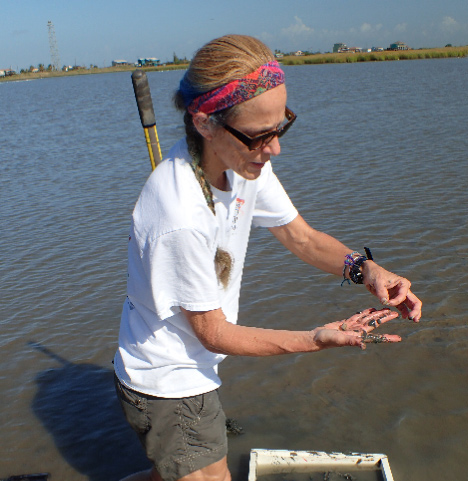Ana Beardsley Christensen

Department Chair
Office: 101 A Maes Building
Phone: 409-880-8260
Email: christenab@lamar.edu
Education:
- 1985 B.S. in Biology, College of William and Mary
- 1989 M.A. in Biology, College of William and Mary
- 1997 Ph.D. in Biological Sciences, Clemson University
Courses Taught:
- BIOL 2401 & 2402 Human Anatomy and Physiology
- BIOL 3440 Advanced Physiology
- BIOL 3460 Invertebrate Zoology
- BIOL 4307/5307 Life in the Extreme
- BIOL 4450 & 5450 Marine Biology
- BIOL 4451 & 5451 Marine Invertebrate Zoology
Service:
- Biology Graduate Program Director
- Honors Council
- College of Arts and Sciences Curriculum Council
Research Interests:
I am primarily an invertebrate physiologist, specializing in factors affecting respiration in estuarine and marine organisms (especially the echinoderms). I am also interested in the occurrence of respiratory pigments (such as hemoglobin) in invertebrate organisms and determining how it benefits the organism (i.e. is it used in transporting oxygen, oxygen storage, or some other function?). My current research is focusing on the expression patterns of hemoglobin in an Ophiactis species and environmental variables that may affect expression. My lab is also looking at how variables associated with climate change affect the metabolism of various species of brittle star.
Publications and Abstracts:
Alitto, R.S., M.I. Bueno, P.D.B. Guilherme, M. di Domenico, A.B. Christensen, M. Borges (2018) Shallow-water brittle stars (Echinodermata: Ophiuroidea) from Araçá Bay (Southeastern Brazil), with spatial distribution considerations. Zootaxa, 4405: 1-66
Christensen, A.B., K. Radivojevich, and M.I. Pyne (2017). Effects of CO2, pH, and temperature on respiration and regeneration in the burrowing brittle stars Hemipholis cordifera and Amphipholis gracillima JEMBE, 495: 13-23.
A.B. Christensen, J.L. Herman; M.R. Elphick, K.M. Kober, D. Janies, G. Linchangco, D.C. Semmens, X. Bailly, S.N. Vinogradov, D. Hoogewijs (2015) Phylogeny of Echinoderm Hemoglobins. PloSOne. 10(8):e0129668.
Kashiwagi, T, maxwell, EA, marshal, A, and Christensen, AB (2015) Evaluating Manta ray mucus as an alternative DNA source for population genetics study: underwater-sampling, dry-storage and PCR success. PeerJ 01/2015; 3:e1188. DOI:10.7717/peerj.1188
Radivojevich, K. and A.B. Christensen. 2012. A tale of two brittlestars: A comparison of the effects of decreased pH and increased temperature on the respiration rates of Hemipholis cordifera and Amphipholis gracillima (Echinodermata, Ophiuroidea). Gulf of Mexico Science 29:151-152.
Christensen, A.B., and E.F. Christensen. 2011. Comparisons of Populations of North American Ophiactid Brittle Stars Possessing Hemoglobin Using Intronic Variation. in Echinoderms in a Changing World: Proceedings of the 13th International Echinoderm Conference, C. Johnson (ed.). Pp.127-129.
Christensen, A.B., H.D. Nguyen, M. Byrne. 2011. Thermotolerance and the effects of hypercapnia on the metabolic rate of the ophiuroid Ophionereis schayeri: inferences for survivorship in a changing ocean. JEMBE 403:31-38.
Christensen, A.B., E.F. Christensen, and D.W. Wiesrock. 2008. Population structure of North American Ophiactis spp. possessing hemoglobin. marine Biology 154:755-763.
Bio:
After earning both B.S. and M.A. degrees in Biology from the College of William and Mary, Ana Christensen took a brief break from her academic studies to work at the Virginia Institute of Marine Science. During the three years there, projects worked on included population structure of the bluefish and juvenile fish surveys in Chesapeake Bay. In 1996, she earned her Ph.D. in Zoology from Clemson University, studying the hemoglobins and respiratory physiology of a burrowing brittle star. Her first academic appointment was a teaching fellowship at the College of Charleston in the Biology Department. Her next move brought her to Lamar University where she has been a faculty member in the Biology Department for over 18 years. During this time she has taught a wide variety of courses, many centered around her interests in physiology, invertebrates, and marine biology, and include co-teaching in the LU Tropical Biology program in Belize with Dr. Matt Hoch. Her research continues to focus on the physiology of brittle stars and their responses to changes in the environment and has had the opportunity to mentor over 40 undergraduate students and two graduate students in research activities.
As part of the Tropical Biology Program, she became interested in the brittle stars that inhabit the back reef/reef rubble communities on the Meso-American Barrier Reef. In addition to studies on abundance and distribution of the various species, she has also been examining their role in the community by studying levels of sublethal predation. Another facet of the study is examining the effects of increasing temperature on their physiology and their ability to cope with stress. She has also traveled to Australia, “a global change hotspot”, to study the effects of short term exposure of brittle stars to ocean acidification and warming. This fall she will return to Sydney to study long exposure effects as well as their effects on larval development.